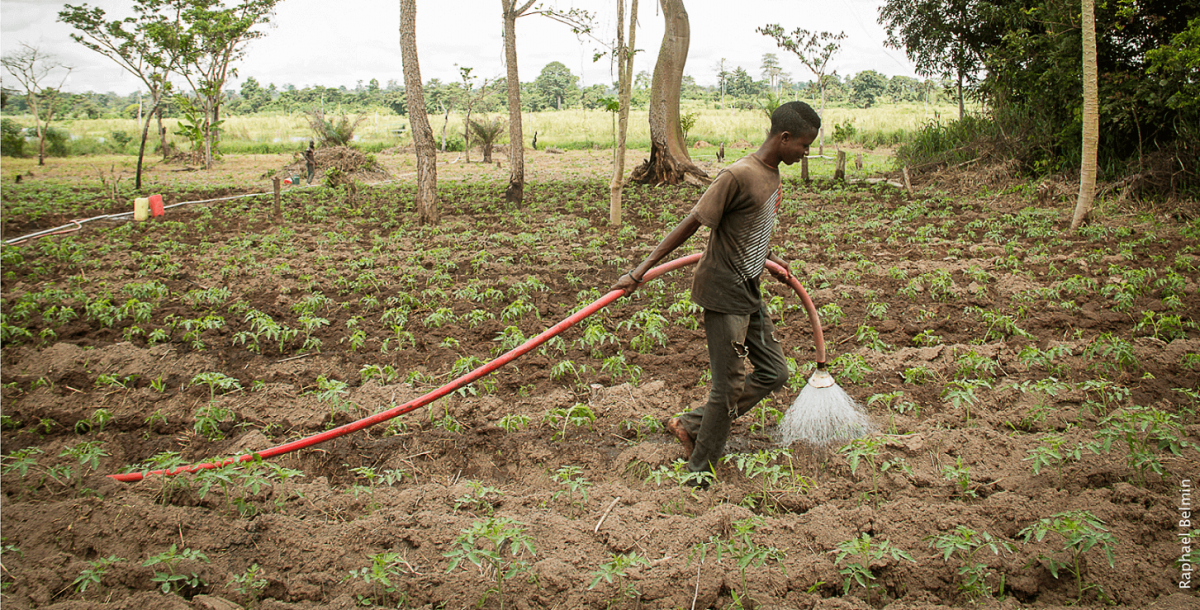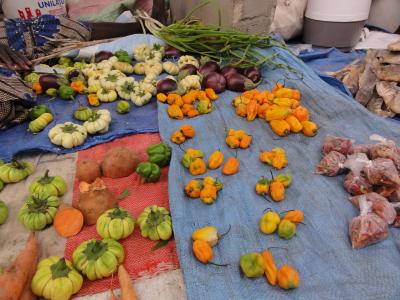Results & impact 10 October 2025
- Home
- Press area
- Press releases
- Choice of crop species faced with climate change
Faced with climate change, farmers in Africa and Asia are turning to “thirsty” crops

Tomato field in Yamoussoukro, Côte d'Ivoire © R. Belmin, CIRAD
Local observations by farmers report the adoption of horticultural crops (fruit and vegetables) in 38% of cases, and 47% of the crops abandoned being cereals. The authors of the study thus highlight a tendency among farmers to turn to high value crops, which are often irrigated, even if this means reducing their efforts on cereal crops that are not irrigated but less profitable.
“The irregularity of rainfall has resulted in a reduction in yields of non-irrigated crops for many farmers in Africa and Asia”, explains Vanesse Labeyrie, an agronomist and ethnoecologist at CIRAD and lead author of the study. “To overcome this problem, there is a general tendency to turn to irrigated horticulture, with the hope of improving income. This behaviour is often linked to government economic incentives, which are aimed at boosting commercial agriculture for export or for urban areas”.
Greater dependence on international trade and external food sources
These changes are nevertheless impacting nutrition for the rural populations concerned.
“Cereals are high in calories but low in vitamins, and the opposite is true for fruit and vegetables”, says Vanesse Labeyrie. “We are therefore seeing a reduction in the local production of calories and an increase in the production of vitamins. Depending on the area, this can have positive or negative impacts on nutritional intake. The production of fruit and vegetables does not always benefit local populations, as in some cases, all of this production is sold. However, in all cases, the reduction in cereal crops means farmers are more dependent on international trade and more exposed to variations in market prices”.
Towards better integration of local knowledge
“It is thanks to farmers’ observations that we have been able to produce this report”, says Vanesse Labeyrie. “We have very little data on the way in which climate change is impacting rural populations and their approach to crop diversity in the global South. Good knowledge of local changes nevertheless helps to better understand the different needs according to the territories, and therefore to build public policies to support agriculture that are better suited to the specificities of each area. For this reason, in the absence of data, local observations by farmers are a valuable source of information”.
Field studies are planned for this year in around 15 territories in Africa, Asia, Latin America and Europe*, in the context of the CITRON group (assessing Crop dIversity TRends based on lOcal kNowledge). The first analysis, on the groundnut basin in Senegal, has just been published. In this zone, farmers have little scope to adapt by changing the crops they grow. Indeed, the region’s naturally salty water limits the development of horticulture. In the two villages studied, the farmers therefore continue to produce millet, groundnuts and cowpeas. They are adapting to climate change by increasing the diversity of varieties, showing themselves to be highly reactive in their choice of varieties with long or short cycles depending on changes in rainfall.
* The areas studied are in the following countries: Brazil, Chile, China, France, India, Italy, Madagascar, Morocco, Senegal and Spain
References
Vanesse Labeyrie, Delphine Renard, Yildiz Aumeeruddy-Thomas, Petra Benyei, Sophie Caillon, Laura Calvet-Mir, Stéphanie M. Carrière, Marilou Demongeot, Elsa Descamps, André Braga Junqueira, Xiaoyue Li, Jonathan Locqueville, Giulia Mattalia, Sara Miñarro, Antoine Morel, Anna Porcuna-Ferrer, Anna Schlingmann, Julia Vieira da Cunha Avila and Victoria Reyes-García. 2021. The role of crop diversity in climate change adaptation: insights from local observations to inform decision making in agriculture. Current Opinion in Environmental Sustainability.
F. Ruggieri, A. Porcuna-Ferrer, A. Gaudin, N. F. Faye, V. Reyes-García, V. Labeyrie. 2021. Crop diversity management: Sereer smallholders’ response to climatic variability in Senegal. Journal of Ethnobiology




























